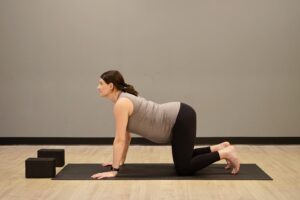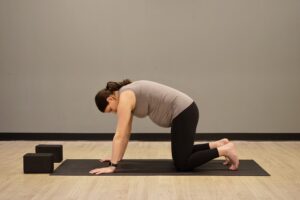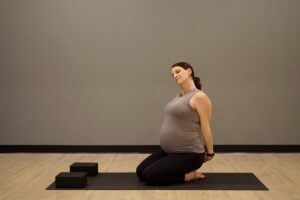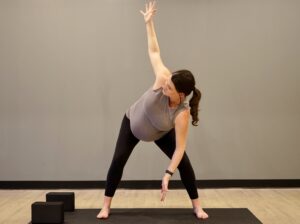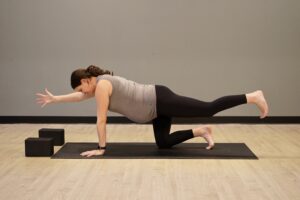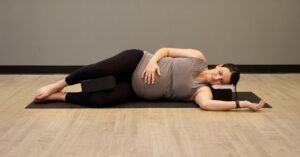Navigating the physical and emotional changes during pregnancy can be challenging. The good news is with the right adjustments you can maintain your yoga practice to benefit your pregnancy physically and mentally. Although pregnancy comes with its ups and downs, it is a wonderful time in life to connect with yourself and embrace your strength within. Research shows yoga during pregnancy helps improve sleep, reduces stress, increases strength, flexibility, and endurance, and decreases some pesky symptoms like low back pain and headaches. Childbirth and the 4th trimester (postpartum) also benefit from a prenatal yoga practice.
You are likely wondering, can I keep going to the yoga classes that I love? First and foremost, always check with your doctor. Each pregnancy is different so you want to make sure you are listening to the advice from your care team. Your body is growing a human (let that sink in), so it is important you listen to what your body does or does not need each time you arrive on your mat. Check your expectations and ego at the door and be prepared to be amazed with the connection and growth you can find as a yogi and parent-to-be
General Guidelines
Some good reminders are to stay hydrated, avoid getting overheated, and pace yourself. Moving at a pace that serves you may not match the rest of the class, especially into your third trimester. That is ok! You will want to avoid ujjayi breath since it is a heat building breath. Instead, simply focus on your inhalations and exhalations. This is a great time to practice belly breaths to optimize your breathing and prepare for birth. At any point you feel overheated or lightheaded, make your way into child’s pose or a comfortable seat.
You will want to be mindful of overstretching during pregnancy. The body produces the hormone relaxin to loosen muscles, joints, and ligaments in preparation for birth. To avoid injury, be conscientious of your edge. Try to maintain the same range of motion you had pre-pregnancy. As your pregnancy progresses you may notice pelvic instability due to changes in weight and the added relaxin. We will explore slight adjustments within common postures to help keep you feeling at your best! Majority of pregnancy modifications come down to making room for baby and increasing stability. Baby will continue to grow, so our modifications will continue to evolve. A few postures that benefit from a wider stance include standing forward fold, halfway lift, downward facing dog, mountain pose, child’s pose, ragdoll, and other postures in which you are hinging at the hips. As for seated forward fold, take a wide legged seated forward fold, butterfly, or janu sirsasana.


Maintaining glute strength is important in pregnancy. Strong glutes help with pelvic stability and you will thank yourself postpartum! In chair pose, take your feet a bit wider (hip distance is a good rule of thumb), isometrically draw your feet away from one another while hugging your inner thighs in as if there was a block. BOOM, your glutes are fired on! Be mindful your knees stay in line with the middle toe to avoid your knees caving in.
If you come to a yoga class it is a safe bet you will experience warrior II, extended side angle, and reverse warrior. You’ve likely heard the cue, “Create a 90 degree bend in your front leg” or, “Stack your knee over your front ankle.” As your pregnancy progresses you will actually want to come out of your front lunge a bit. The reason being? Your friend relaxin is preparing your body for birth, but results in looser hips and less pelvic stability. To provide more stability and avoid overdoing it, shorten your stance just a bit and give yourself permission to come out of the lunge. Be mindful of your front knee tracking inward. Tack your knee toward your front pinky toe. This will not only protect your knee, but will help strengthen your external hip rotators. In Extended Side Angle a block can feel amazing between your thigh and forearm. This will help create a little more space for baby and lengthen your side bodies.

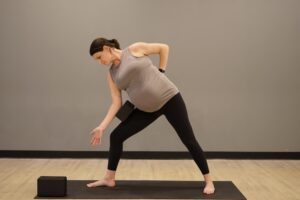
Cow and cat are great postures to warmup the spine and open the chest. In cow pose, allow your belly to be heavy. It is such a relief to get baby off of your back! Draw your shoulder blades together and enjoy length across your collarbones. As for cat pose, the rounding in will continue to decrease as the baby grows. Take this series of postures slow and really feel the movement progress from your tailbone and along each vertebra.
Transitions
Blocks are your best friend. Let me say that again, blocks are your best friend. Take all the blocks! You will want at least two blocks for your practice. As you progress into your third trimester you may want three or four blocks.
Transition from Downward Facing Dog to Forward Fold:
- As your pregnancy progresses, take your feet wider apart as you journey to the top of your mat. Have your blocks waiting for you at the top of the mat to use in any upcoming transitions like halfway lift. You may also choose to have the blocks already under your hands in downward facing dog. Remember there are multiple heights to the blocks, so find what is comfortable for you.
Transition from Downward Facing Dog to Low Lunge:
- For much of your pregnancy this transition may feel ok, but have blocks waiting for you at the top of the mat. You can gently rest your fingertips on the blocks for added support. You may need a wider stance in low lunge as well to make room for baby. Like the above transition, it may feel nice to have blocks under your hands while still in downward facing dog. This give your leg more room between the mat and belly to transition.
Lastly, you can always drop to your knees from downward facing dog into table top. From here, swing your leg forward to create your low lunge. Use the blocks for support as you press your back knee away from the mat if you choose.
Chaturanga:
- When the teacher calls out chaturanga, this is a series of poses – high plank, mid plank (chaturanga), upward facing dog, and downward facing dog. Each of these postures come with options and it is important to know these options whether you are pregnant or not. There are a lot of combinations for how your chaturanga may look, but here are a few options:
- Chaturanga from your knees
- Skipping chaturanga all together and holding a mid plank or table top
- Table top, cow pose (see more above), downward facing dog
Chaturanga is a fancy way to go from the front of your mat to the back. I love to keep things simple in this transition during pregnancy. For instance, from reverse warrior cartwheel your hands to the mat or blocks and step back to downward facing dog. Enjoy an extra breath here to pedal your feet or find stillness until the class all meets in downward facing dog.
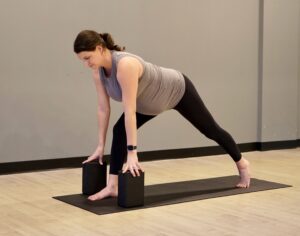
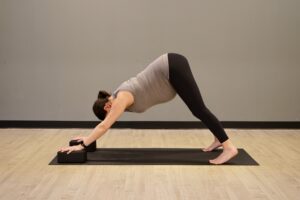
Prone Postures (on your belly)
During the second trimester, or whenever your belly begins to grow, you will want to avoid prone postures on your belly (low cobra, locust, sphinx, floor bow). A great alternative is table top and a round of cow and cat. In cow pose really allow your belly to relax. It can be a relief to get the baby off of your back for a brief moment while safely opening your chest. A few personal favorites are sitting back on my heels and finding a bind behind my low back. From here, tip your right ear to your right shoulder to get a nice neck and trapezius stretch. Repeat on the other side. A gentle camel may also be taken from knees with hands on your low back.
Twists
When it comes to pregnancy modifications, twists get a lot of attention- rightly so! Due to the growing baby your organs are having to shift into different positions (how cool is that?!) and there is less space overall. Not to mention your center of gravity is constantly changing. Avoid deep twists such as revolved crescent lunge and chair prayer twist. Instead, incorporate a gentle vertical twist with the focus of the twist at your mid spine and above. This can be a great chest opener to counter the rounding inward that occurs during pregnancy. For added support take a hand to your low back. To create even more space you can find an open twist by twisting away from your bent leg – make sure to give your neighbor a quick smile!
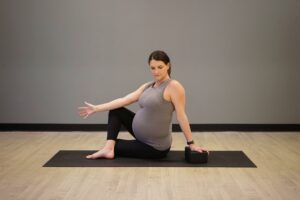
Instead of chair with prayer twist you could also take your feet extra wide and hook your left forearm to your left inner thigh. Then, reach your right arm up to the sky. This can be a great stretch through your tight adductors, but also allows your chest to open.
As for seated twists you can follow the same guidelines above by finding an open twist (twisting the opposite direction, away from your bent leg). Focus on length rather than depth – not the time to wring out! If you are ok being on your back for a few moments, supine twist can be an excellent gentle twist. Use a block under your top leg and behind your back as a wedge. This creates a little more stability and support.
In general, keep your twists gentle and focused on length rather than depth. Twists can be an excellent way to maintain range of motion within your spine and open your chest. Just do so mindfully and listen to your body. A good rule of thumb is to check your breath. If your breath is feeling shallow or nonexistent, time to back out of the twist.
Core
During pregnancy you can develop diastasis recti (DRA)- the separation of your left and right rectus abdominis. This can hinder core recovery postpartum. Avoid crunching postures that limit space for baby and create “coning” in your abdomen. Instead, focus on neutral spine core work. Table top, spinal balance, and modified side plank are great alternatives. Clamshells and bridge pose (alternative for wheel pose) are also great options to build strength and stability.
During the core portion of a yoga class it is an ideal time to focus on your breathwork.
- Take a comfortable seat on the mat or sitting on a block.
- Take a big belly breath in, allow your pelvic floor to relax.
- On your exhale, gently draw your belly button toward your spine as if you are giving baby a hug; option to find a kegel as well. This will activate your deepest core muscles, the transverse abdominis. For a kegel, contract your pelvic floor as if you were stopping your stream of pee.
- Repeat for several rounds of breath.
Full disclosure, I love core work as a time to sneak in postures I need within my body. Pregnancy comes with its fair share of aches and pains, so you do you! A few favorites are child’s pose with a lat stretch, gentle shoulder roll, firelog, malasana, or butterfly pose.
Balance
Balance is challenging enough on a good day! During pregnancy your center of gravity is constantly changing and relaxin may result in bigger feet and overall less stability. During balance, remember to drop your ego and welcome in some patience and grace!
- Tree pose or eagle – kick stand your leg.
- Standing figure four can feel amazing for the piriformis and glutes during pregnancy, but grab your blocks on the highest height under your hands.
- In one legged mountain, stack your shoulders over your hips to avoid arching back. To increase your stability, take your hands to heart center or hips.
If you can, place yourself near a wall for class. This is an excellent tool we often forget to use! When transitioning in and out of balance postures remember to take your time, create a soft bend in your knee, and kickstand your foot whenever needed.
Supine Postures (on your back)
The vena cava is a major vein that brings blood to your heart. Into the 2nd and 3rd trimester when lying on your back, the baby can compress the vena cava making you feel dizzy or nauseous. So what about savasana? Some women are comfortable on their back for a few minutes, especially with blocks propped beneath their knees. If you feel nauseous or lightheaded though, this is not for you. A great alternative is to lie on your left side for savasana. Place a block beneath your cheek for a pillow and another block between your legs. If taking Restore, stack two blocks and lean your bolster along the blocks. Lie back on the ramp you have created for the most relaxing savasana ever!
Supine twist can look many different ways, so adjust as you need and use all the blocks. A seated open twist is also a great alternative to a supine twist. The pelvic muscles and inner thighs can become tight and achy during pregnancy. If you are comfortable on your back for a few rounds of breath, happy baby will help open up your inner thighs and pelvis. From seated, butterfly pose is a great alternative.
Lastly, when transitioning from the mat to a seat avoid crunching and “coning” through your core. Instead, roll onto one side and press yourself up with your hands. This will help prevent DRA and creates more stability for your spine during transitions.
Favorite Postures
Pregnancy is an amazing time to connect with yourself and baby. It also comes with plenty of aches and pains that seem to change everyday. Use this time in your life to grow your practice by listening to what you truly need and noticing how postures feel within your body. What are a few of your favorite yoga postures during pregnancy? What have you discovered about yourself on this journey?
Here are a few of my favorites!
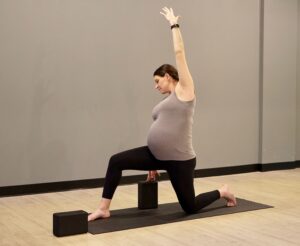
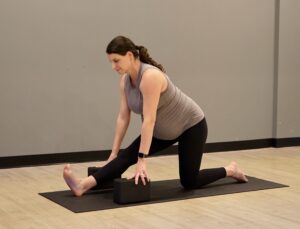
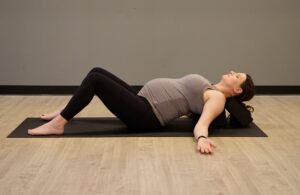


 By Kelli Harris
By Kelli Harris 
